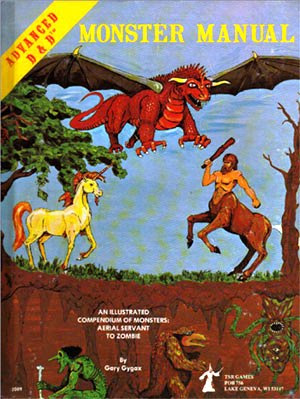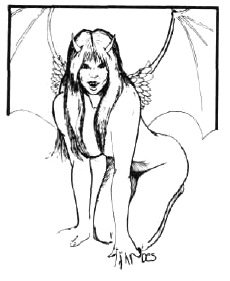Having already converted the demons from the original Monster Manual, I was required to consider how devils should be differentiated from demons in this conversion. I decided to retain the lawful nature of devils, although I otherwise treated them as demons. As before, some deviation from the strict order of presentation is required to allow for invoke patron results, with the archdevils being sone first (one per post), and then the other devils.
Of all the archdevils in the Monster Manual, Dispater is the most generically written. While this is fine for AD&D, conversion to DCC requires a bit more “meat”, especially in terms of invoke patron results. Luckily, the archdevils in the Monster Manual all come from real-world sources, so there is plenty of material available to flesh him out!
My original plans had not included doing the other monsters (but not all of the gods!) from the Deities & Demigods cyclopedia, and I had been waffling on converting the Monster Manual II, but I think I’d like to have these done for my own reference, which means that you will get them for your reference as well. There are some unique monsters made for 2nd and 3rd Edition – I quite like the ethereal filcher and the grick, for instance – so it might be worthwhile to do those as well. Let me know what you think in the comments.
Dispater (Archdevil): Init +8;
Atk rod +16 melee (4d6) or stare or spell; AC 22; HD 18d12 (144 hp); MV 40’;
Act 2d20; SP devil traits, stare, spells; SV Fort +10, Ref +10, Will +16; AL L.
Stare: Dispater’s stare can cause a chill (2d12 cold damage, Fort DC 24 for half) or fear (-2d on dice chain for all rolls, lasting 1d4 rounds, Will DC 24 negates) in a single opponent, as desired by the archdevil.
Devil traits: Telepathy, immunities (weapons of less than +5 enchantment or natural attacks from creatures of 12 HD or less, fire, cold, electricity, gas, acid), projection (teleport at will to any location, as long as not bound or otherwise summoned; can project astrally and ethereally), crit range 15-20.
This archdevil rules Hell’s second plane from his infernally
grand palace in the iron city of Dis. The city is filed with un-dead, damned
from the lands of the living, which are often little more than zombie-like
slaves. Erinyes are found there in abundance, as well as a sprinkling of barbed
and horned devils. The entire plane is called Dis by mortals, after the iron
city of its ruler, but it also has a secret name known only to the lords of
Hell.
Dispater appears as an evilly handsome man, a full even feet tall, with only his small horns, tail, and cloven left hoof distinguish him from humanity. Some mortal cultists know him as Rex Infernus (King of Hell), believing Dispater to be superior to Asmodeus. Others know him as Dis Pater, Dis, Soranus, Taranis, Aericura, or even Śuri. He is considered by some to rival Orcus as Lord of the Dead. Sacrifices are made to propitiate Dispater on round marble alters by those venturing below the earth in search of buried treasures, including precious ores and gemstones, for Dispater is known to jealously protect that wealth which lies below the surface world. These offerings may be as simple as food or flowers, but also include sacrificial animals (particularly wolves and goats), and, in some places, even the sacrifice of humans and other sentient creatures.
Dispater is also associated with volcanoes, thunder, storms, and oracular visions – both through dreams and through breathing fumes which arise from deep underground. The ceremony to bond with Dispater must take place in a subterranean area where such fumes are present, and the caster spends the casting process weaving in and out of dreams and visions.
Invoke Patron check results:
12-13 The Father of Wealth is not impressed by the caster, but provides them with a gift. All the silver on their person is transformed into gold, and all the copper into silver. In some cases, as with silver weapons, this might make them less useful (as per judge). If the caster survives, this gift is theirs. If the caster should die, it is a gift to whoever loots the caster’s body.
14-17 Surely this has happened before, in a dream or in a vision. Instinctive knowledge of the future grants the caster a +2 bonus to all d20 rolls, which lasts for 1d6+CL rounds. During this time, the caster may choose to re-roll and one d20 roll, keeping the better of the two results, but doing so ends the bonus immediately. (The bonus still applies to the re-roll.)
18-19 A gout of lava and volcanic gas busts upward at any one target chosen by the caster within line of sight and 500 feet. The target takes 4d12 damage (Reflex DC 15 for half), and if it survives must succeed in a DC 15 Fort save or be overcome by the mephitic fumes, falling unconscious for 4d6 rounds, during which it cannot be awakened save by magic.
20-23 The Lord of the Dead keeps and protects you. If the caster is dropped to 0 hp or would otherwise be slain during the next 1d6+CL turns, they instead instantly disappear, being transported to the iron city of Dis. There they spend 1 subjective year per turn remaining (or portion thereof) of the original effect before reappearing at the end of the duration, healed and whole. If the caster did not know the Infernal tongue before, they know it now, and can speak no other language for 1 hour per year spent in Hell. At the judge’s discretion, the caster’s time in Hell may result in new spell knowledge or adventure hooks, and/or some service to be performed once returned to the mortal plane.
24-27 The Lord of the Dead guides and defends you. For the next 1d6+CL hours, any humanoid creature slain by the caster (through any means) arises as a zombie the following round. The caster can directly control CL zombies. The remainder become free-willed un-dead bent upon consuming the living, but they ignore the caster and any allies within 100 feet of the caster unless attacked by them. These zombies are persistent, and last until destroyed. Moreover, any zombies created by this result and controlled by the caster can cast second sight (+0 bonus to the spell check) on behalf of the caster, when asked a specific question, although doing so destroys the zombie immediately thereafter. So long as the caster is able to create new zombies with this result, they may transfer their control to any zombie(s) so created, if they are within 100 feet and they are currently controlling fewer than CL zombies.
28-29 One foe within line of sight of the caster must succeed in a DC 25 Will save or be transformed into solid gold for the next 1d6+CL hours. A human-sized creature weighs nearly 3,000 pounds once so transformed, but chunks can be cut off the victim…potentially killing them once they revert to flesh and blood. Although the judge can rule otherwise, it is recommended that 100 gp weighs a pound, but minting increases the value of coinage, so that a pound of un-minted gold is worth only 10 gp. The entire statue, though, is potentially priceless as a work of art. Anyone who purchases this gold or accepts it in payment is in for a ghoulish surprise once the effect has worn off….
30-31 As 28-29, above, but with a DC 30 Will save and the effects are permanent. Dealing with a lump of gold this size, of course, leads to its own complications as it sparks infernal avarice in most who see or hear of it (as per judge).
32+ Dispater transports the caster before his jeweled throne in the iron city of Dis. There, the caster may rest, recuperate, regain spells, etc., as desired for as long the caster requires. As a guest in the palace of Dispater, the caster has an opportunity to receive the best advice regarding the situation awaiting their return to the mortal plane, and can bargain with the archdevil to gain needful favors or gifts. Although these come with a high price, and are only granted to those who show Dispator the utmost deference and respect, there are few limits to what the fiend can give or do, and a companion can even be returned from death (although that companion will now and forever be bound to Dispater). When the caster is ready to return to the mortal plane, they reappear exactly where they were, and no time has passed.


























